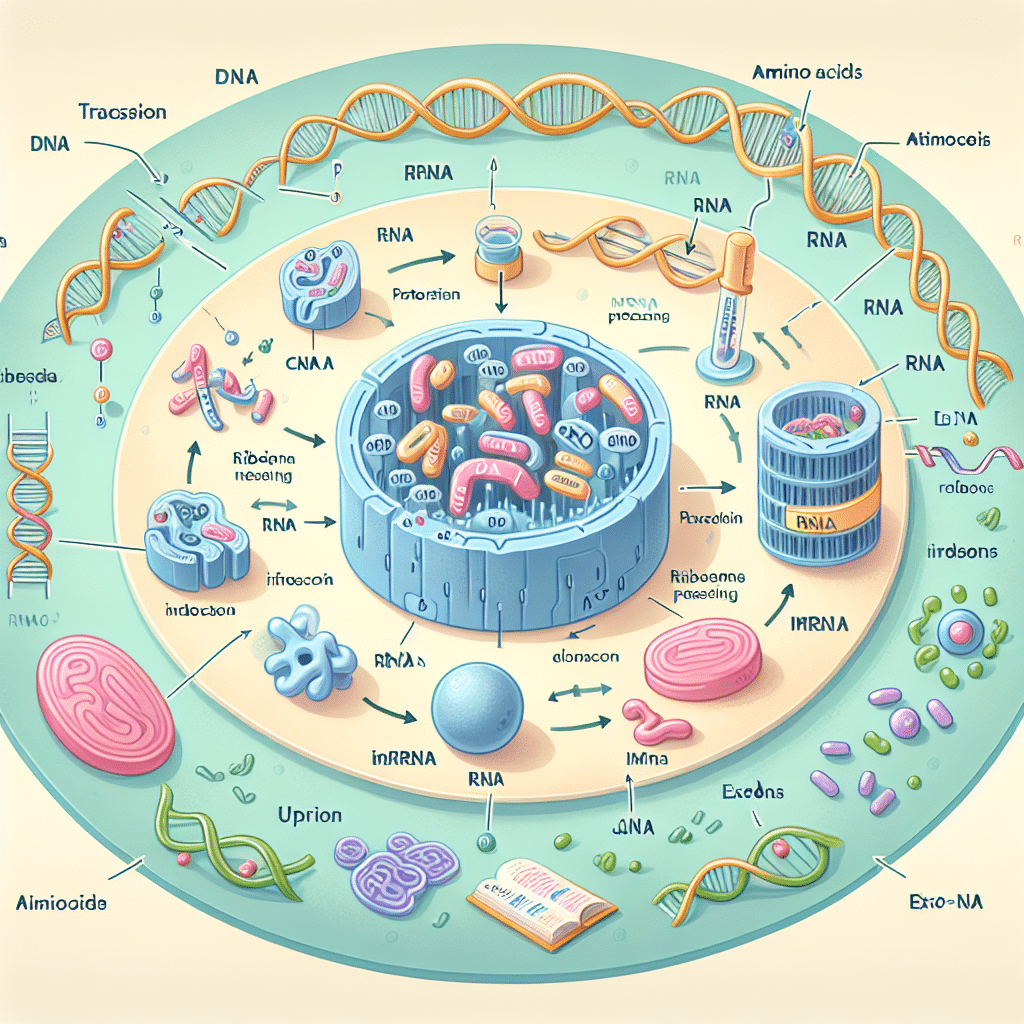Bioflix Activity: Protein Synthesis RNA Processing Explained
-
Table of Contents
- Protein Synthesis and RNA Processing: A Detailed Exploration
- Understanding the Basics of Protein Synthesis
- The Role of RNA Processing in Protein Synthesis
- Splicing: A Closer Look at RNA Editing
- RNA Processing and Disease
- Technological Advances in Studying RNA Processing
- Case Studies: RNA Processing in Action
- Conclusion: The Significance of RNA Processing in Protein Synthesis
- Discover ETprotein’s High-Quality Protein Products
Protein Synthesis and RNA Processing: A Detailed Exploration

Protein synthesis is a fundamental biological process that underpins the growth, repair, and maintenance of all living organisms. Central to this process is the role of RNA processing, a complex series of events that ensures the accurate translation of genetic information into functional proteins. This article delves into the intricacies of RNA processing within the context of protein synthesis, providing a comprehensive understanding of this vital biological phenomenon.
Understanding the Basics of Protein Synthesis
Before we explore RNA processing, it is essential to understand the basics of protein synthesis. Protein synthesis is the process by which cells construct proteins based on the instructions encoded within DNA. This process can be divided into two main stages:
- Transcription: The first step involves copying the genetic code from DNA into messenger RNA (mRNA).
- Translation: During this stage, the mRNA is used as a template to assemble amino acids into a polypeptide chain, which then folds into a functional protein.
Both stages are crucial for the accurate expression of genes and the proper functioning of proteins within the cell.
The Role of RNA Processing in Protein Synthesis
RNA processing is a critical step that occurs between transcription and translation. It involves the modification of the primary RNA transcript into a mature mRNA molecule that can be translated into a protein. This process includes several key steps:
- Capping: The addition of a 5′ cap to the beginning of the RNA molecule, which is essential for stability and initiation of translation.
- Splicing: The removal of non-coding sequences called introns, and the joining of coding sequences known as exons.
- Polyadenylation: The addition of a poly-A tail to the 3′ end of the RNA, which aids in nuclear export, translation, and stability.
Each of these steps is meticulously regulated and essential for the production of a functional mRNA that can be translated into a correct protein sequence.
Splicing: A Closer Look at RNA Editing
Splicing is perhaps the most complex aspect of RNA processing. It is carried out by a large RNA-protein complex known as the spliceosome. The precise removal of introns and the ligation of exons are critical for generating the correct mRNA sequence. Errors in splicing can lead to the production of dysfunctional proteins and are associated with various diseases.
Alternative splicing is a variation of this process, where the same pre-mRNA can be spliced in different ways to produce multiple mRNA variants, and thus, different proteins. This increases the diversity of the proteome and allows for complex regulation of gene expression.
RNA Processing and Disease
Given the importance of RNA processing in protein synthesis, it is not surprising that defects in this process can lead to disease. Mutations that affect splicing patterns can result in the production of aberrant proteins that contribute to conditions such as cancer, spinal muscular atrophy, and cystic fibrosis.
Research into RNA processing has led to the development of therapeutic strategies aimed at correcting splicing defects. For example, antisense oligonucleotides can be used to modify splicing patterns and restore normal protein function in certain genetic disorders.
Technological Advances in Studying RNA Processing
Advancements in technology have greatly enhanced our understanding of RNA processing. High-throughput sequencing techniques allow for the comprehensive analysis of RNA transcripts and their processing patterns. Bioinformatics tools enable the prediction of splicing patterns and the identification of potential splicing mutations.
Moreover, educational tools like Bioflix Activity for protein synthesis provide interactive experiences that help students and researchers visualize and understand the complex processes involved in RNA processing and protein synthesis.
Case Studies: RNA Processing in Action
Several case studies highlight the importance of RNA processing in protein synthesis. For instance, the study of the human immunodeficiency virus (HIV) has revealed how the virus exploits the host’s splicing machinery to produce multiple proteins from a single gene. Understanding this process has been crucial for the development of antiretroviral therapies.
In another example, research into the genetic disorder myotonic dystrophy has shown how a mutation in the RNA processing pathway leads to the misregulation of several proteins, causing muscle wasting and other symptoms.
Conclusion: The Significance of RNA Processing in Protein Synthesis
In conclusion, RNA processing is a vital component of protein synthesis, ensuring that genetic information is accurately translated into functional proteins. The complexity of this process and its implications for health and disease underscore the importance of continued research in this field. By understanding RNA processing, scientists can develop targeted therapies for genetic disorders and improve our overall understanding of cellular function.
Discover ETprotein’s High-Quality Protein Products
If you’re interested in the practical applications of proteins beyond the cellular level, consider exploring ETprotein’s range of plant-based protein products. Whether you’re involved in the food and beverage industry, sports nutrition, or health and wellness, ETprotein offers a variety of protein solutions to meet your needs.
About ETprotein:
ETprotein, a reputable plant protein vegan protein Chinese factory manufacturer and supplier, is renowned for producing, stocking, exporting, and delivering the highest quality organic bulk vegan protein and plant proteins. They include Organic rice protein, clear rice protein, pea protein, clear pea protein, watermelon seed protein, pumpkin seed protein, sunflower seed protein, mung bean protein, peanut protein etc. Their offerings, characterized by a neutral taste, non-GMO, allergen-free attributes, cater to a diverse range of industries. They serve nutraceutical, pharmaceutical, cosmeceutical, veterinary, as well as food and beverage finished product distributors, traders, and manufacturers across Europe, USA, Canada, Australia, Thailand, Japan, Korea, Brazil, and Chile, among others.
ETprotein specialization includes exporting and delivering tailor-made protein powder and finished nutritional supplements. Their extensive product range covers sectors like Food and Beverage, Sports Nutrition, Weight Management, Dietary Supplements, Health and Wellness Products, and Infant Formula, ensuring comprehensive solutions to meet all your protein needs.
As a trusted company by leading global food and beverage brands and Fortune 500 companies, ETprotein reinforces China’s reputation in the global arena. For more information or to sample their products, please contact them and email sales(at)ETprotein.com today.












